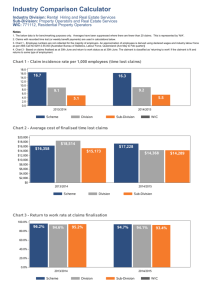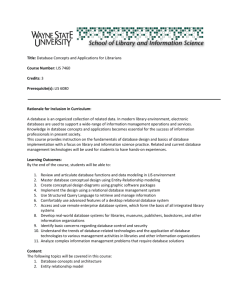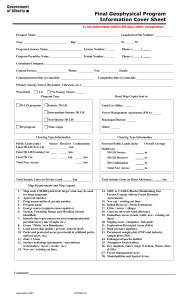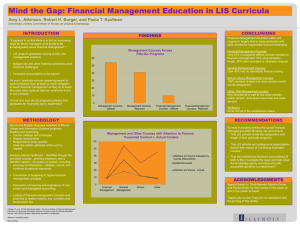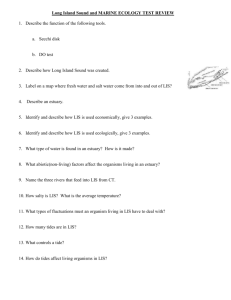Implementation & Progress Report: Closure of Physical LIS Library
advertisement
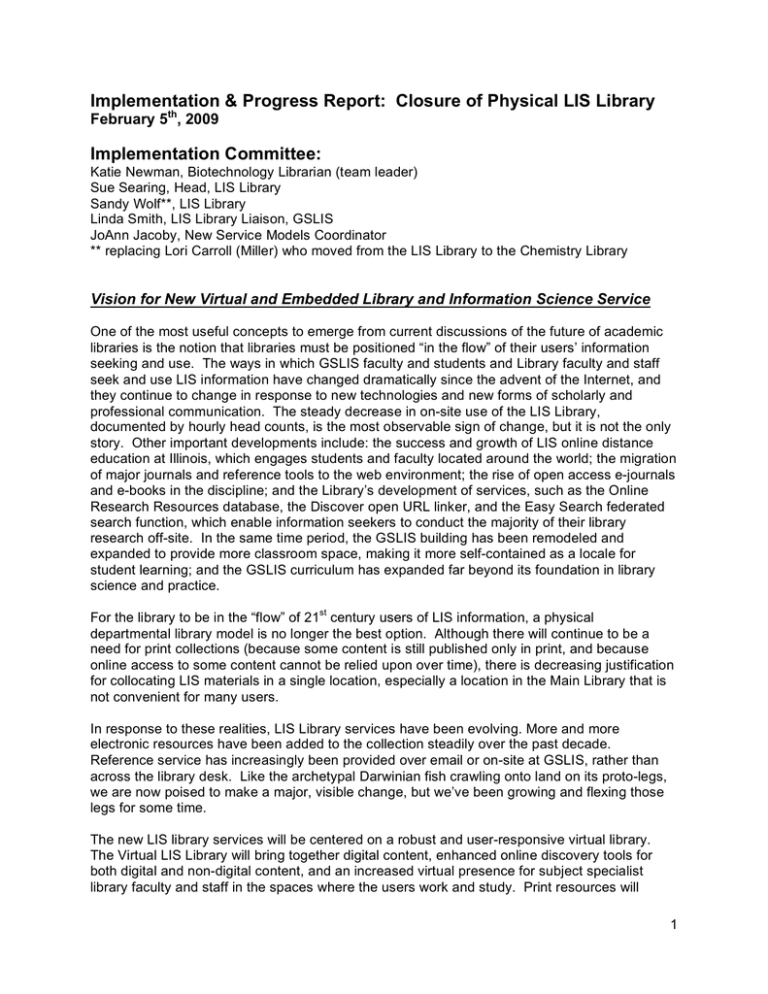
Implementation & Progress Report: Closure of Physical LIS Library February 5th, 2009 Implementation Committee: Katie Newman, Biotechnology Librarian (team leader) Sue Searing, Head, LIS Library Sandy Wolf**, LIS Library Linda Smith, LIS Library Liaison, GSLIS JoAnn Jacoby, New Service Models Coordinator ** replacing Lori Carroll (Miller) who moved from the LIS Library to the Chemistry Library Vision for New Virtual and Embedded Library and Information Science Service One of the most useful concepts to emerge from current discussions of the future of academic libraries is the notion that libraries must be positioned “in the flow” of their users’ information seeking and use. The ways in which GSLIS faculty and students and Library faculty and staff seek and use LIS information have changed dramatically since the advent of the Internet, and they continue to change in response to new technologies and new forms of scholarly and professional communication. The steady decrease in on-site use of the LIS Library, documented by hourly head counts, is the most observable sign of change, but it is not the only story. Other important developments include: the success and growth of LIS online distance education at Illinois, which engages students and faculty located around the world; the migration of major journals and reference tools to the web environment; the rise of open access e-journals and e-books in the discipline; and the Library’s development of services, such as the Online Research Resources database, the Discover open URL linker, and the Easy Search federated search function, which enable information seekers to conduct the majority of their library research off-site. In the same time period, the GSLIS building has been remodeled and expanded to provide more classroom space, making it more self-contained as a locale for student learning; and the GSLIS curriculum has expanded far beyond its foundation in library science and practice. For the library to be in the “flow” of 21st century users of LIS information, a physical departmental library model is no longer the best option. Although there will continue to be a need for print collections (because some content is still published only in print, and because online access to some content cannot be relied upon over time), there is decreasing justification for collocating LIS materials in a single location, especially a location in the Main Library that is not convenient for many users. In response to these realities, LIS Library services have been evolving. More and more electronic resources have been added to the collection steadily over the past decade. Reference service has increasingly been provided over email or on-site at GSLIS, rather than across the library desk. Like the archetypal Darwinian fish crawling onto land on its proto-legs, we are now poised to make a major, visible change, but we’ve been growing and flexing those legs for some time. The new LIS library services will be centered on a robust and user-responsive virtual library. The Virtual LIS Library will bring together digital content, enhanced online discovery tools for both digital and non-digital content, and an increased virtual presence for subject specialist library faculty and staff in the spaces where the users work and study. Print resources will 1 continue to be collected and preserved, reflecting the hybrid nature of scholarly communication in LIS, but will no longer be aggregated in one location. Befitting the highly interdisciplinary nature of LIS scholarship and teaching, new and existing print materials will be distributed among disciplinary collections and the Main Stacks. GSLIS’s experience with the LEEP program has taught us a vital lesson: the face-to-face, personal element is more important than ever in a predominantly online environment. Therefore, the LIS subject specialists will be “embedded” both at GSLIS and at the Main Library, the two places most frequented by their primary users. Implementation and Progress Report Vacate the current LIS Library space The LIS Library will close it doors on May 15th, 2009 (the last day of the spring semester) and will vacate the space by June 19th. Materials are being transferred to Oak Street as quickly as possible from both LIS and STX. All materials going to departmental libraries will also be transferred before the end of the spring semester leaving nothing in LIS except materials headed for Main Stacks. Those materials will be bulk transferred from LIS to STX so that the new location of Stacks is accurately reflected in Voyager and Online Catalog after May 15th. It is anticipated that the materials will be moved from LIS to Stacks on book trucks and reshelved in their new location by June 15th. The LIS library will be closed half days during Spring Break, for a processing blitz. Initially, the bulk of the LIS collection (the 020-028 range) will be shelved on Deck 2 East. This is admittedly not the most user-friendly area of the Stacks, due to extremely low ceilings and older furnishings. As the Stacks shift progresses, these materials will be moved to Deck 4. Monographs: The LIS Library streamered all monographs in the LIS Library for transfer to Oak Street, the Main Stacks, or departmental libraries. Based on a Voyager usage report for the 020s area of the LIS Library and the Main Stacks, materials that have not been checked out since 2002 are being transferred to Oak Street, as are some second copies, older editions, and annual reports. The Information Processing and Management (IPM) team is pulling materials based on that report; IPM and LIS are processing transfers. IPM has also provided major assistance in training LIS staff. The goal is for the LIS collection in the Main Stacks to be comprised of useful and current materials, or those titles for which browsing is essential. Although the bulk of the LIS collection is in the 020 Dewey range, there are significant holdings in the 016s, 070s, 302s, and 600s. Work is underway to identify materials in the STX within these ranges that can be moved to Oak Street in order to make space for the incoming material from LIS. As of February 13, 2009 the following numbers of LIS books have been moved by LIS, IPM, or Undergrad: From LIS to Oak Street………… 8,046 From STX to Oak Street……….. 9,640 From LIS to other libraries……... 239 Total: ………………………….. 17,925 2 Depending on how many serials can go straight to Oak Street from LIS, approximately 2025,000 additional volumes will need to be transferred from Stacks to Oak Street by May. Serials: Work is under way to identify the LIS serials for which there is stable e-access; these volumes will be moved to Oak Street. It is anticipated that there are between 20-25,000 serial volumes that will be moved to Oak Street, both from LIS and STX. Many of the serials in Stacks have only Marcette records; CAM has indicated they can update these records by May 1 thanks to additional funding from the Library and a grad hourly supported by funds from the LIS Library. Significant progress has already been made on providing full bibliographic records for the historical collection of library annual reports. Bulk transfer of remaining LIS materials to Main Stacks: After the Oak Street materials have been transferred out of the 020s range in the Main Stacks, the area will be tidied and the materials remaining in the area will be reshelved before the LIS materials are transferred in. At the end of May, the records for monographs and serials that are remaining in LIS will be bulk loaded to reflect their new Main Stacks location. Distribute Parts of the LIS Library Collection to Appropriate Departmental Libraries Appropriate subject specialist librarians have been contacted and are reviewing the materials in LIS. Selected monographs and serials have already been transferred to the Education & Social Sciences, Communications, Engineering, and Rare Books & Manuscripts libraries. The LIS Fiction collection has been integrated into the Undergraduate Library collection. Additional transfers may be made into other locations. We expect selections to be complete by early February. Find a Home for the Unbound LIS Periodicals The Serials Stacks Group has decided that there should not be a centralized periodicals location, so locations are being sought for all LIS journals that are currently being received in print. Sue Searing is reviewing the currently received periodicals in order to identify titles for which print can be cancelled thanks to adequate online access and to find appropriate locations for housing the print. Some titles are candidates for transfer to Grainger, some may go to Communications, History, Philosophy & Newspaper, Rare Books & Manuscripts, and the Conservation Lab, but most will likely be transferred to ESSL, where the LIS periodicals would join the other social sciences unbound periodicals. A complication is that the ESSL will likely be asked to absorb many of the serials titles from the Main Stacks central periodicals location when it closes. The centralized check-in team in Acquisitions will need to be made aware that their check-in work load may increase as they are called upon to check in materials currently received in LIS, processing these titles for the various hosting departmental libraries. Change of address notifications will also need to be sent to the publishers, with some of the materials destined for ACQ and others going directly to other departmental libraries. 3 Move the LIS Reserves Collection It was proposed that the LIS print reserves move into a centralized reserves service behind the Central Circulation Desk. However, due to intensive activities in the Main Stacks during the coming summer, launch of the new service has been deferred until Fall 2009. Arrangements have been made for the LIS Reserves to be moved to ESSL for the summer sessions, and then moved into Central Reserves for the Fall Semester, 2009. ESSL is a good temporary location due to its extended hours. LIS faculty will be notified of the location changes. LIS staff (Sandy Wolf) will continue to be the contact person for LIS print reserves during the summer. Move the LIS Reference Collection to the Main Reference Room An agreement has been reached for the LIS Reference Collection to move to the Main Reference Room in 200 Library. This will not happen until immediately after the LIS library closes. In the meantime, the LIS Library will assess the space needed. The Reference Library will shift its collection to accommodate the LIS Reference material in advance. Move the “Cataloging Table” and Thesaurus Resources to the Reference Library Cataloging instructors have reviewed the titles currently on the Cataloging Table and in the Thesaurus Collection, and discussions are underway about moving these sub-collections to a location in the Reference Library or to GSLIS. GSLIS will take possession of the LIS Library’s card catalog as a teaching and demonstration tool. Provide Space for the Librarian and Staff Member in the Main Library The LIS Librarian and staff member will retain both their current offices on the 3rd floor through the summer, and will keep at least one of the offices indefinitely. Improve Main Stacks Environment for LIS Core Materials After the “big shift” in the Main Stacks is completed, wherein it is expected that the 020s will move from the 2nd level stacks to the 4th level, some renovation and improvements in the LIS collection space should be made to accommodate users. For example, the nearby study carrels should be removed to create space to work with the materials and the folio stands should be replaced with browsing tables. A computer with scanning capability should be located nearby. Ideally, we would like to see wireless capability in the Main Stacks. It is also desirable that a photocopier be located in close proximity to the space. It will also be necessary to do various things to make the area look nice, such as washing and repairing windows, cleaning the floors and shelving, refreshing the lighting, and making sure that the outlets are functional. Discussions are underway concerning the disposition of the LIS armchairs, coffee tables, and area rugs. It is likely they will be re-purposed to another public service area which is frequented by LIS users, such as the Education and Social Sciences Library, the new I3 space, or the revamped Central Circulation area. Provide an LIS “Easy Search” A GSLIS student and Grainger GA, Josh Bishoff, has programmed a federated search tool for Library Literature, LISA, and LISTA. Bill Mischo is working with him to develop it into a fullfeatured Easy Search tool for the discipline. This search option will soon appear on the LIS web site. Provide a More Robust LIS Web Portal Sue is working with two independent study students to make the LIS Web site more robust and interactive. 4 Improve “New Titles @ UIUC Library” Jon Gorman has been tasked with improving the “New Titles @ UIUC Library” service so that results can be scoped by fund, as well as location and call number. Other improvements include the additions of book covers and Table of Contents information pulled from the Syndetic Solutions feed and a revamped interface. The enhancements are expected to be launched by April 2009. This will replace the very popular LIS Library Virtual New Book Shelf. Maintain and Enhance Services for Off-campus GSLIS Users Academic Outreach, which has been processing materials for off-campus LIS students, will no longer be funding its own library service after Summer 2009. Interlibrary Loan and Central Reference will be providing many of the library support services formerly provided by this position. It is important that the 1-800 phone number be maintained. Sue is working with Merinda Hensley to assure a smooth transition for LEEP students, and Sue is a member of the new User Education Committee working group on instruction for students at a distance. Upcoming GSLIS Summer Instruction Dates Given the timeline for closure of the LIS Library (May 15th), we are especially attentive to resource needs of instructors teaching courses in summer. In particular we will be sure students have access to materials needed for Summer I classes in the period May 18-June 13: Library Buildings (last 2 weeks of summer I) Fred Schlipf Rare Books, Crime & Punishment (last two weeks of summer I) Travis McDade Medieval Codicology (first 2 weeks of summer 1) Sid Berger Rare Book and Special Collections Librarianship (first 2 weeks of summer 1) Sid Berger Reference Sources for Rare Books (last 2 weeks of summer 1) Joel Silver Additionally: On-campus session for LEEP courses is June 13-17 Boot camp is July 16-25 and July 23-August 1 Summer Session II for on-campus begins June 15 Implementation Timeline A separate spreadsheet is being maintained where we are keeping track of the particular components of implementation. As it is a work in progress and is constantly changing, it is not being submitted with the Implementation & Progress Report, but is available upon request. 5

